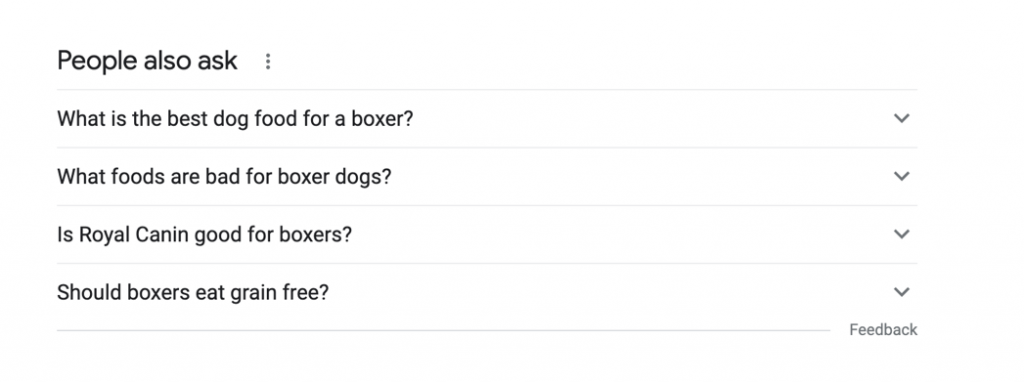Writer’s Block when Blogging—we have all experienced it. We sit down and are all set to write, but we don’t know what to write about. A million different topics run through our brain, but which do we choose? What do readers want to see? How can we attract our target audience? We want to write about a topic that has meaning and will also be ranked high for organic visibility so everyone can read it and to do so we must include SEO.
How to Find Blog Topics that Will Attract Your Target Audience
- Outline your blog strategy
- Define your target audience
- Set your goals
- Review Google search results
- Conduct keyword research
Researching Blog Topics
Start off with outlining your blog strategy. You need to define your target audience and the type of traffic you are trying to receive. Take a moment to set specific and manageable goals on where you want your blog post to take you. Next, head to the know all tell all which is Google. Google will tell you all you need to know about your target audience. What they are searching for and what they want to see. Doing a simple Google search can help with this but there are other tools you can use as well. Two Google Tools you should use are Google People Also Ask and Google Trends.
Google People Also Ask: The People Also Ask box is a direct answer to the questions people are searching for online. It is a Google search engine results page (SERP) feature displayed with questions answered closely related to the searcher’s intent.

Google Trends: A free Google tool that shows popularity in what people are searching for on Google. You can use Google Trends to find relevant categories, a new niche, keyword research and more.

How to Find Your Content Through Keyword Research
- Google search results
- Google Trends
- Keyword research tools
- Review your competition
Keyword Research
After using your own research paired with the Google tool mentioned before, it’s time to dive into more in-depth keyword research. Keywords are the words and phrases that people type into search engines. Keywords are also known as search queries. Keyword research is the process of understanding your target audience and provides actual search data that will help you get answers on what your audience is searching for, how many are searching for it and how they want to receive that information.
It’s important to incorporate keyword research in your blog content because it’s the only way to find out what people are searching for in search engines. You don’t want to waste your time writing a blog with information that no one actually cares about, so you have to do your research. Keyword research also helps answer those blog topic research questions like “How hard will it be to rank for this keyword?” and “What content should I create for this keyword to rank?”
How to Find Keywords for Your Blog
Keyword research doesn’t have to be hard. There are ways to conduct it, including tons of Keyword Research tools out there. Some are free and others require a monthly/annual fee. Check out our previous blog post, Free, Quick and Easy Keyword Search Tools and Tips for SEO and Audience Insights, for more information. Let’s take a look at a couple of the top ones:
Ubersuggest: A free tool that will provide a list of terms that are related to any primary keyword. This tool provides volume data, keyword suggestions, keyword difficulty and more. It also gives related content to your keyword under Content Ideas.
Ahrefs: A popular tool that is an SEO guide to improve rankings and help you with keyword research. Using Ahrefs Keyword Explorer, you can find keyword ideas just by typing a keyword or phrase into the search box. Ahrefs then provides an extensive list of keyword suggestions. Ahrefs also allows you to see the keywords that your competitors are ranking for so you can target those as well. Ahrefs offers plans starting at $82/month.
Researching Your Competition
Once you have decided on your primary keywords, it’s time to scout the competition. If you want your blog to rank well, you need to have the mind of a search engine. Google’s job is to give the people what they want, and they want specific answers to their questions quickly. You want to be the one Google shows the searcher when they type in their question. You want to be front and center and to do so, you must research your competition.
How do you do that? You can start by using Google or a keyword search tool that provides a look into your competition and take note of these key things:
- Who is ranking for this specific topic?
- What titles did they use?
- What points did they make in their piece?
- Did they leave out anything of importance?
Take notes of the answers to these questions you find. Now that you know what you’re up against, you are ready to compose a piece of content that can compete with your competitors.
Composing Your Blog with SEO
After your keyword research is complete, you are ready to compose your blog post. There are several parts to creating an illustrious blog post with SEO.
Title
First impressions are everything and your title is just that – EVERYTHING! You want readers to get sucked in by your title. Using one of your primary keywords, write something captivating that readers can’t help but click on and read all the way through. Add a teaser in the headline or make it a list – Ex. “10 Things Successful People Do Before 9AM”. People love lists. This is the first thing people will see when searching Google, so keep them interested.
Headings
Headers assist Google’s crawlers in understanding your blog and all the sections inside of it. Make sure you are using those same keywords from your research in your headings. Your H1 should cover your primary keyword(s) while your H2s, H3s and more should highlight your sub-topic keywords.
Link to High Authority Websites
Linking internally is something you should never be afraid of when planning out your blog post. Linking to a reputable site allows readers to expand their knowledge on the subject, but it also lets search engines know you did your research on the topic.
Add Images + Alt Text
Many readers are also visual learners, and we want to keep them interested and reading our posts. Describing what is in the actual photo, helps those who are visually impaired understand why you included the images in your post. This also helps Google understand the images as well. You can read more on the topic here.
Meta Description
Just like your headings, you want to be sure that you are including your keywords in your meta description. You want to compose a compelling meta description to entice the reader to click your link. Increasing your click through rate through your meta description could influence higher rankings. You will find the meta descriptions underneath the title of a result. Sometimes Google may decide whether to change your meta description, but still use this to stand out in the crowd against your competition.

Once you have optimized your blog with all these tips, you are ready to post! Using this blog and other resources as a guide can help you write more targeted posts and start to receive more organic traffic. One thing to remember is to make sure you are writing a blog that isn’t all about keyword stuffing, but is something readers want to read about and understand at the same time. Keep the users’ interests in mind when writing and you will gain a loyal following. We care about the rankings and the organic traffic we will receive, but we want to make sure we truly solve the users’ needs, and our readers keep coming back for more!




